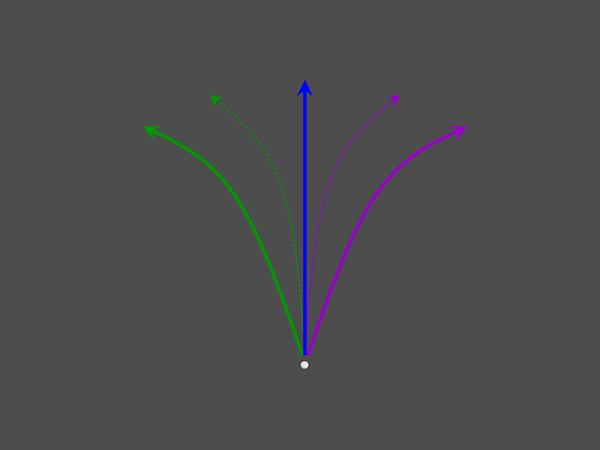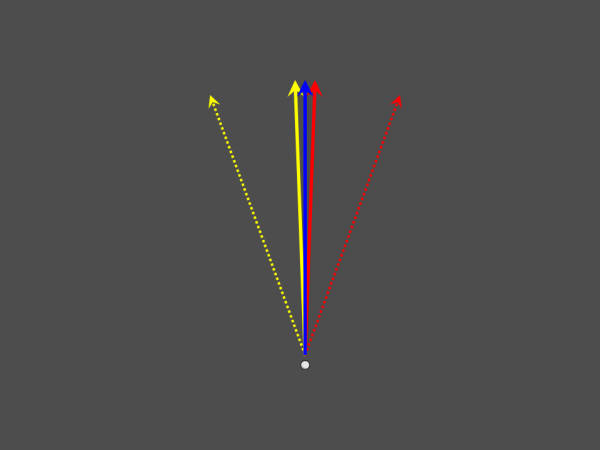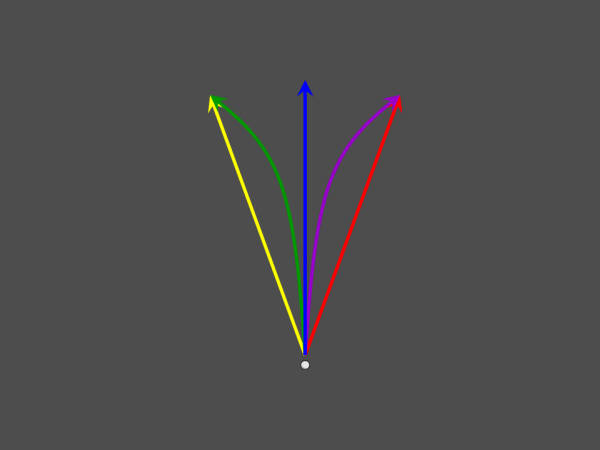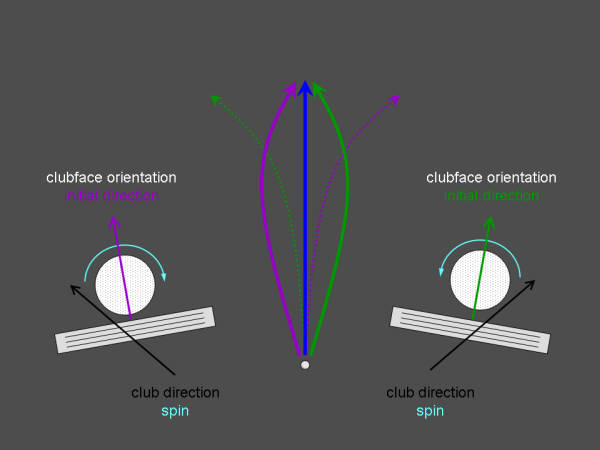
"Hitting a golf ball straight is not as easy as it seems like it ought to be."
Learn from the Ball
There are a lot of significant muscular movements simultaneously combining to generate a dramatic impact on the ball, and that at one moment when the club meets the ball, the head of the club needs to be oriented in a particular way and moving in a particular direction. When these two factors - club orientation and direction - are not aligned, sidespin will be imparted to the ball causing it to fly with a curved trajectory.
Without high-speed video, it is difficult in real time to discern the direction of travel of the club and the orientation of the club relative to that direction. Both of these vary greatly throughout the swing. The relevant facts are their directions at the moment of impact, since the golf ball only contacts the club for a small fraction of a second before it is on its way beyond the golfers influence anymore. The good news is that the ball will reveal to us both of these pieces of information and then we can learn how to control it.
Recognizing that there are really only two inputs that the golf club imparts to the ball - direction and spin - and that they influence the flight of the ball in uniquely different ways, we can apply two principles that reveal how the ball was struck.
1. The initial direction of the ball identifies the orientation of the clubface at impact.
2. The curvature of the ball's flight reveals the spin, and hence the direction of the club relative to the
orientation of the clubface.
When a golf ball is hit, there are several possibilities for its final destination and how it gets there. A ball can end up to the right or left of the intended target either by going straight that way, or by curving in that direction. In order to correct the off-target result, it is important to know why it happened, because there are two different possible reasons, so we need to be able to address the real cause.
If your shots are curving off target and you want them to go straight, then you have to figure out how to hit the ball with the club moving in the direction of the target while maintaining the club face's orientation toward the target. The curvature of the ball's flight reveals the direction that the club must have been moving when it hit the ball in order to have made it spin and curve off target. This enables you to adjust your swing path accordingly. The ball does not lie (until it stops), so you can learn from what it tells you about what you did to it.
Another common unintended result is that the ball starts off in a direction other than at the target and then also curves even further off target. While this seems like there are two things wrong, in fact, there could only be one. If the club's direction is toward the target, but the face is oriented to the right, the initial direction will be to the right (perpendicular to the clubface) and the horizontal spin will be clockwise (because the club's direction was to the left of its orientation), so the ball will curve right. Knowing that the ball's initial direction and its subsequent curvature from that direction reveal the club's orientation and direction allows for an adjustment of only the club's orientation in order to produce a straight shot in this case. This may only require an adjustment of grip rather than swing. The solution is enabled by the knowledge learned from the ball.
It is important to be able to discern what the ball indicates about how it was hit in order to correct unintended results. A shot starting out off target has the clubface oriented off target. A shot that curves is due to a club direction different than the clubface orientation. Either one or both of these could be in error, so pay attention to where the ball starts and how it changes direction.

If you find that your shots start out in the intended direction and are consistently curving one way, you can apply the same recalibration of aiming that would work for misaimed straight shots in order to make the ball end up where you want, but by following a curved path. Adjust your stance to change your aim by the amount that the ball missed the target and hit the same shot. This can be harder to do when aimed in a different direction because there is a tendency to alter the shot to try to make it go where you want, but that has already been compensated for by altering your aim, so just hit it the same way as before. Consider that in order for the ball to curve and end up where we want, it must start out off target and then curve back to the target. For example, to start the ball out to the right, the clubface must be oriented to the right. Then for the ball to spin counter-clockwise to produce force to curve back left, the club's direction needs to be to the right of the club’s orientation. This may seem a little counter-intuitive to orient the club in a direction and then hit it even further in that direction, but that is what produces the spin to bring the ball back from that direction. Now we just figured out how to hit a curved shot, which has value, so the ball just taught us something else.
By using the information from the flight of the ball to identify the only two parameters that effect the direction and path of the ball - club orientation and direction at impact - we can learn what and how to adjust in order to produce a desired result. Particularly when the objective is to hit the ball straight, since that does not occur only when these two factors are not aligned, the ball can teach us the cause and enable us to compensate. A basic understanding of what the club does to the ball provides the golfer with feedback that directly allows for meaningful changes in how the club strikes the ball.

If the ball starts out toward the intended target and stays on a straight path to that target, then both the clubface and the direction of the club were aligned toward the target. The club's face and direction must be aligned to produce a straight shot.
If the ball starts out to the right and continues straight to the right, then the clubface was aligned in that direction and the direction of the club was also in that direction. No spin was imparted because the ball merely went straight in the direction that the clubface was pointed.
If the ball starts out toward the intended target, but then curves to the right, then the clubface was oriented toward the target because the ball started in that direction, but the path of the club was from right to left when the ball has hit, which caused the ball to spin clockwise (looking down) and develop aerodynamic force toward the right (the side with the higher velocity flow) and curve to the right.
The same goes for if the ball ends up to the left of the intended target. Either the ball went straight toward the left, meaning the club's face and direction were oriented toward the left, or the ball started out toward the target and then curved to the left, indicating that the club's face was oriented toward the target, but the club's direction was from left to right when the ball was hit (causing counter-clockwise spin).
Armed with this knowledge when you go to the practice range, you can easily discern how you must have hit the ball in order for it to go where it did, which allows you to alter your grip or stance or swing to produce a desired result. It matters that if your shots are ending up to one side that you recognize whether they went straight that way, so you can correct your aim, or whether they curved over there so you can adjust other things about your swing.
Simply having shots go straight, but off target, is a relieving problem to have, because you can merely adjust your initial stance and then hit the same swing to make the ball go straight to where you want. That is a matter of recalibrating your aim.


Identify the clubface orientation and club direction of these shots.
Recognizing why the ball did not go straight allows that to be corrected.